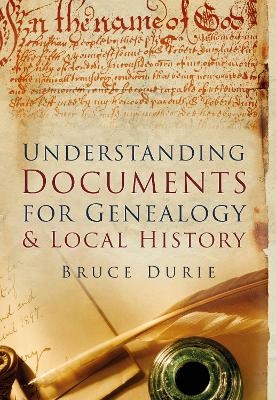
Understanding Documents for Genealogy and Local History
Seiten
2013
The History Press Ltd (Verlag)
978-0-7524-6464-0 (ISBN)
The History Press Ltd (Verlag)
978-0-7524-6464-0 (ISBN)
Genealogists and local historians have probably seen every birth, marriage, death and census record available, and are adept at unsing the internet for research. However, once they have learnt everything they can from them, the next step is reading and understanding older documents.
Genealogists and local historians have probably seen every birth, marriage, death and census record available, and are adept at using the internet for research. However, once they have learnt everything they can from them, the next step is reading and understanding older documents. These can be hard to find (not many are online), are often written in challenging handwriting and use legal and other unfamiliar terms. Some will be in Latin, antiquated English or Scots. Readers need to be able to understand the nature and intent of a range of documents as well as the palaeography (the handwriting) and orthography (the ‘shape’ of the contents). In Understanding Documents for Genealogy and Local History, Dr Bruce Durie, the celebrated author of Scottish Genealogy, details how to find and comprehend documents from 1560 to the 1860s – wills, testaments, contracts, indentures and charters, land records (retours, sasines and manorial custumals), personal letters, official records, Church papers, trust dispositions, deeds and others. Also covered are the complexities of dates, numbers, calendars, measurements and money, abbreviations, transcription conventions, letter-forms and glossaries. A Latin primer completes the tool kit the genealogist and family historian will need to further their research.
Genealogists and local historians have probably seen every birth, marriage, death and census record available, and are adept at using the internet for research. However, once they have learnt everything they can from them, the next step is reading and understanding older documents. These can be hard to find (not many are online), are often written in challenging handwriting and use legal and other unfamiliar terms. Some will be in Latin, antiquated English or Scots. Readers need to be able to understand the nature and intent of a range of documents as well as the palaeography (the handwriting) and orthography (the ‘shape’ of the contents). In Understanding Documents for Genealogy and Local History, Dr Bruce Durie, the celebrated author of Scottish Genealogy, details how to find and comprehend documents from 1560 to the 1860s – wills, testaments, contracts, indentures and charters, land records (retours, sasines and manorial custumals), personal letters, official records, Church papers, trust dispositions, deeds and others. Also covered are the complexities of dates, numbers, calendars, measurements and money, abbreviations, transcription conventions, letter-forms and glossaries. A Latin primer completes the tool kit the genealogist and family historian will need to further their research.
BRUCE DURIE is course director for genealogical studies at the University of Strathclyde. He presents the genealogy programme Digging Up Your Roots on BBC Radio Scotland and is the author of numerous books, including Scottish Genealogy (THP, 2009, 2010). He lives in Edinburgh.
| Erscheint lt. Verlag | 1.2.2013 |
|---|---|
| Verlagsort | Stroud |
| Sprache | englisch |
| Maße | 165 x 235 mm |
| Gewicht | 320 g |
| Themenwelt | Sachbuch/Ratgeber ► Geschichte / Politik ► Regional- / Landesgeschichte |
| Schulbuch / Wörterbuch ► Lexikon / Chroniken | |
| Geschichte ► Hilfswissenschaften ► Genealogie | |
| ISBN-10 | 0-7524-6464-7 / 0752464647 |
| ISBN-13 | 978-0-7524-6464-0 / 9780752464640 |
| Zustand | Neuware |
| Haben Sie eine Frage zum Produkt? |
Mehr entdecken
aus dem Bereich
aus dem Bereich
Akteure - Praktiken - Perspektiven
Buch | Hardcover (2022)
De Gruyter Oldenbourg (Verlag)
CHF 139,90
